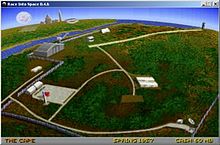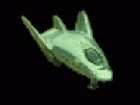Buzz Aldrin's Race Into Space
| Buzz Aldrin's Race Into Space | |
|---|---|
 | |
| Developer(s) | Strategic Visions |
| Publisher(s) | Interplay Productions |
| Platform(s) | MS-DOS,PC-98 |
| Release | |
| Genre(s) | Turn-based strategy,Construction and management simulation |
| Mode(s) | Single-player,Multiplayer |

Buzz Aldrin's Race Into Space,frequently abbreviatedBARIS,is a1993space simulation strategy game forMS-DOS.The player takes the role of Administrator ofNASAor head of theSoviet space programwith the ultimate goal of being the first side to conduct a successful crewedMoon landing.[4][5]It was developed by Strategic Visions and published byInterplay Productionsas a computer version ofLiftoff!,a 1989board gamedeveloped by Fritz Bronner.[6]BARISwas re-released in 1994 onCD-ROM,incorporating the earlier updates to thefloppy diskversion, a few new updates, improved video of the mission launches,[7][8]and new multiplayer modes.[9]
The developers worked to maintain historical accuracy, including all the actual major space hardware and several alternative proposals that were considered at the time, but did make some compromises and simplifications in the name ofgame balanceand avoiding complexity.[10]They also consultedApollo 11astronautBuzz Aldrin,who gave permission for his name to be used for the game.[11]
Gameplay
[edit]Buzz Aldrin's Race Into Spacehas two sides, the United States and the Soviet Union,[4]unlikeLiftoff!which supported up to four (the other two sides inLiftoff!were Europe and Asia).[12]Each player controls aspace center,which doubles as a navigational menu, and directs funding toward purchasing hardware,research and development,recruiting and trainingastronauts,and conducting launches.[4]
While the ultimate goal of the game is to conduct a successful crewed Moon landing, it is necessary to complete several milestone achievements to ensure success.[4][13]Historical milestones in the game range from launching asatellite,[4]likeSputnik 1,to conducting alunar orbitalmission, likeApollo 8.Skipping a milestone results in a safety penalty to any mission depending on it.[13]For example, skipping a crewed lunar orbital mission would cause a safety penalty to all mission steps during a Moon landing mission.[14]
Play begins in spring of 1957 and proceeds with turns lasting six months each for up to 20 years to the end of 1977,[4]or until the first player successfully conducts a crewed Moon landing, or until one player is dismissed from his/her program (this happens rarely, and only to a human player who is essentially doing nothing). At the start of each turn, the game randomly chooses an "event card" to give the player, usually with a piece of historical information, and sometimes with positive or negative effects on the game.[6]For example, the player may be informed thatOperation Papercliphas increased the effect of research and development for that turn.[15]
On the way to the Moon landing, the two space programs compete for prestige in order to secure funding. Players gain prestige points through space exploration "firsts", which include historical milestone missions that improve lunar mission safety, but also ancillary achievements, such as the first Mars flyby (historicallyMariner 4) or firstwoman in space(historicallyValentina Tereshkova). The player to make the second successful mission of a certain type will typically gain some prestige points, whereas subsequent missions may earn very few or no points. Prestige points are lost through mission failures, especially those involving astronaut/cosmonaut fatalities.
The heart of the game is the space missions, which come down todicerolls. At each step of a mission, the safety factor of the relevant component is checked against a random number, adjusted by relevant astronaut skill bonuses (if the mission is crewed), safety penalties and other factors. If the check fails, an error occurs. Such an error may range from catastrophic mission failure down to no effect (e.g. "The first imprint in the lunar surface is in fact made by a helmet visor. Crewman okay." ). Placing a satellite in orbit has three steps, while a Moon landing can have well over twenty. Missions are generally non-interactive; occasionally during an incident, the player may be given the option of aborting or proceeding.
History
[edit]Development
[edit]While developingLIFTOFF!withTask Force Games,Fritz Bronner had considered making a computer version, but did not find much interest within Task Force.[16]As Task Force had notoptionedtheLIFTOFF!computer game when they were contractually able, Bronner decided to undertake the development independently. In November 1990 he met and recruited then 22-year-old Michael McCarty as programmer and formed Strategic Visions as a partnership, but concluded that publishing would be too daunting a task. They initially decided to program forAmigaand released a videotape demo on that platform in June 1991. However, by September they concluded that the Amiga market was shrinking and decided to change platforms toIBM PC compatible.[17]
In August 1991, Strategic Visions signed with Interplay Entertainment to publish the game, with a projected release of May 1992. By this time, Buzz Aldrin was on the project in an advisory role. It was also around this time that Bronner added the feature of astronaut/cosmonaut skills and morale, which previously made no impact on the performance of a mission.[18]Astronaut/cosmonaut skills were initially randomized at the start of each game.[11]
Strategic Visions and Interplay showed a demo ofBuzz Aldrin's Race Into Spaceat the 1992Consumer Electronics ShowinLas Vegas, Nevada,and also held a reception atCaesars Palacewhere Buzz Aldrin spoke about his experiences in the space program.[19]
Software testingbegan in September 1992, which proved a daunting task: one tester calculated that with all mission types and hardware permutations factored in, there were over 12,000 possible missions. With failure modes factored in, this number increased to approximately 50 million possible mission outcomes.[20]
In January 1993, the informative companion to the manual was the last major step delaying shipping. The book was written by Anthony Mesaros with help from NASA and was a detailed description of the Space Race with Russia and a very detailed description of the various rockets and space modules the US and Russia had created. Anthony had the book completed before the game was done but took 2.5 weeks to do the layout, design, and edit and then another 6 weeks before it came back from the printers.[20]
Release
[edit]In March 1993,Buzz Aldrin's Race Into Spacewas ready to be released after a production which had lasted 28 months.[20] The final floppy disk version had some 100megabytesof photographs and animations cut due to space limitations, and the then-planned modem play was cut as well. Immediately upon completion of the floppy version, however, work began on the CD-ROM version.[20]The CD-ROM version was produced by Interplay's Rusty Buchert, who also producedDescent.[21] BARISwas re-released in 1994 onCD-ROM,incorporating the earlier updates to thefloppy diskversion, a few new updates, improved video of the mission launches,[7][8]and new multiplayer modes.[9]
Source code release
[edit]
In 2005, after thebankruptcyof publisher Interplay the developers released the game'ssource codeunder aGPLlicense and the game's content asfreeware.[22]The resulting project, now calledRace Into Space,is hosted onSourceForge.[23]The game has now beenportedto modern operating systems and additional platforms (for instancePandora[24]), with some improvements over the original. Development at SourceForge has ceased, and is continuing, slowly, now onGitHub.[25]
Buzz Aldrin's Space Program Manager
[edit]In October 2014,Slitherine Strategiesreleased the first version of a game titledBuzz Aldrin's Space Program Manager.The game focuses on research, development and mission planning, and shares many features with the original BARIS,[26]but is much more detailed.
Reception
[edit]While Interplay[2]and others[27]had billed the game upon its release as being appropriate for children as young as age 10, it drew criticism for being extremely difficult.[28][29]It was also criticized byThe Guardianas being "rather lifeless".[30]Computer Gaming Worldwas more positive, wishing for a CD-ROM version but stating that it was a "game that should appeal to anyone with even a casual interest in space exploration".[31]
The game received a 90/100 score fromPC Gamer UK,[32]was a finalist for theCOMPUTE!Choice Awards in 1993.[33]In 1994,PC Gamer UKnamedRace Into Spacethe 26th best computer game of all time. The editors called it "the most successful piece of 'educational' software available for the PC".[34]
It has remained popular enough with fans to spawn an open-source version from the original developers at Strategic Visions in 2005,[35][36]which was downloaded fromSourceForgebetween 2005 and 2017 over 90,000 times.[37]Some of the improvements mentioned above have made the game less difficult.
Realism
[edit]
While Strategic Visions worked to accurately simulate space launches and the act of running either space program, they made a number of simplifications for balancing as well as for the game to make sense.[10]For example, four NASA launch facilities are condensed into one superfacility.[39]More significant is the elimination of some minor rocket programs, such asRedstone,and the addition ofdockingcapability to theVoskhod spacecraft.[10]There is also a "basic" model in the game which equalizes costs and safety factors between both sides.[40]Despite this,BARISstill features most of the major pieces of hardware and approaches to Moon landing that were considered, includinglunar orbit rendezvous(which was the strategy used successfully inProject Apollo),Earth orbit rendezvous(though in a different form) anddirect ascent.[10]
References
[edit]- ^Buzz Aldrin's Race Into SpaceREADMEfile.
- ^ab"ALL SYSTEMS ARE GO AS INTERPLAY LAUNCHES 'BUZZ ALDRIN'S RACE INTO SPACE'"(Press release).Interplay Entertainment,PR Newswire.1993-04-29. Archived fromthe originalon 2014-11-03.Retrieved2008-08-20.
- ^Atkin, Denny (February 1994)."Three from Interplay".Compute!(161).Greensboro, North Carolina:Small System Services: 96.ISSN0194-357X.OCLC5391833.
- ^abcdefMay, Scott (October 1993)."Buzz Aldrin's Race into Space".Compute!.15(10).Greensboro, North Carolina:Small System Services: 88.ISSN0194-357X.OCLC5391833.
- ^Bronner, Fritz (1993).The Buzz Aldrin's Race Into Space Companion.Berkeley, California:McGraw-Hill.p. 194.ISBN0-07-881938-5.
- ^abVarney, Allen(2005-10-04)."The Buzz is Gone".The Escapist(13): 2. Archived fromthe originalon 2008-09-04.Retrieved2008-08-27.
- ^ab"Buzz Aldrin's Race into Space".Home Computing & Entertainment.North York, Ontario:Plesman Publications: 67. November 1994.ISBN9780078819384.ISSN1205-6723.OCLC36688157.
- ^abPerkins, Lee (1994-09-01). "Archival video clips lift Buzz's rating".The Age.Francis Cooke. p. 22.
- ^abOldenburg, Don; Rob Pegoraro (1994-09-28). "Everything New is Old Again".The Washington Post.The Washington Post Co. p. R27.
- ^abcdBronner, Fritz (1992).Buzz Aldrin's Race Into Space (manual).Irvine, California:Interplay Entertainment. p. 2.
- ^abBronner 1993,p. 340
- ^Bronner 1993,p. 329
- ^abBronner 1993,pp. 201-203
- ^Bronner 1993,pp. 265-266
- ^Bronner 1993,p. 283-284
- ^Bronner 1993,p. 335
- ^Bronner 1993,pp. 337-338, 343
- ^Staff (January 1992)."No More" Spam in a Can ""(PDF).Computer Gaming World.No. 90.Anaheim, California:Golden Empire Publications. pp. 48, 50.ISSN0744-6667.OCLC8482876.RetrievedJanuary 14,2019.
- ^Bronner 1993,p. 344
- ^abcdBronner 1993,pp. 345-346
- ^Brown, Lonnie (1995-04-29). "GAME FANS TAKE THE DESCENT".The Ledger.The Ledger Pub. Co. p. 1C.
- ^CopyrightInfo.txt
- ^sourceforge.net/projects/raceintospace
- ^race-into-space-v1-1-0-02-pandora-game-port(September 8, 2013)
- ^raceintospaceon github
- ^"Buzz Aldrin's Space Program Manager".Slitherine.Retrieved2014-03-10.
- ^May, Scott A. (August 1994)."Games that are good for you".Compute!.16(8).Greensboro, North Carolina:Small System Services: 90.ISSN0194-357X.OCLC5391833.Retrieved2008-08-27.
- ^Black, Dorian (1993-06-01). "Aldrin takes a tame walk into space".The Age.p. 32.
- ^Warner, Jack (1993-10-24). "Two new space programs inform while entertaining Interplay game is history lesson".The Atlanta Journal and Constitution.p. 10.
- ^Minson, John (1993-06-10). "GAMES REVIEWS".The Guardian.p. 17.
- ^James, Jeff (August 1993)."Interplay's Buzz Aldrin's Race Into Space".Computer Gaming World.p. 58.Retrieved12 July2014.
- ^Butcher, Andy."Buzz Aldrins Race Into Space".PC Gamer UK.Future plc.Archived fromthe originalon 2002-05-23.Retrieved2008-08-20.
- ^Bixby, Robert (December 1993)."Compute Choice Awards".Compute!.15(12).Greensboro, North Carolina:Small System Services: 8.ISSN0194-357X.OCLC5391833.
- ^Staff (April 1994). "ThePC GamerTop 50 PC Games of All Time ".PC Gamer UK.No. 5. pp. 43–56.
- ^"Race Into Space Project: Overview".Race Into Space Project.Retrieved2008-08-28.
- ^Varney 2005,p. 3
- ^2000-04-28+to+2017-05-04 downloadsonsourceforge.net
- ^Bronner 1993,p. 138
- ^Chien, Philip; Denny Atkin (July 1994). "Blast off!".Compute!.16(7).Greensboro, North Carolina:Small System Services: 90.ISSN0194-357X.OCLC5391833.
- ^Bronner 1993,p. 195
External links
[edit]- Buzz Aldrin's Race Into SpaceatMobyGames
- Race Into Spaceon SourceForge,a free software port ofBARISto Windows, Linux, and Mac (latest release, v.1.1)
- Race Into Spaceon GitHub,continuing development ofRace Into Spacesince latest release (includes a beta of version 2.0)
- Interplay Entertainment games
- Multiplayer and single-player video games
- Multiplayer hotseat games
- DOS games
- NEC PC-9801 games
- 1993 video games
- Science educational video games
- Business simulation games
- Play-by-email video games
- Commercial video games with freely available source code
- Open-source video games
- Cold War video games
- Video games based on real people
- Buzz Aldrin
- Video games set in the Soviet Union
- Video games developed in the United States
- Video games set in 1957
